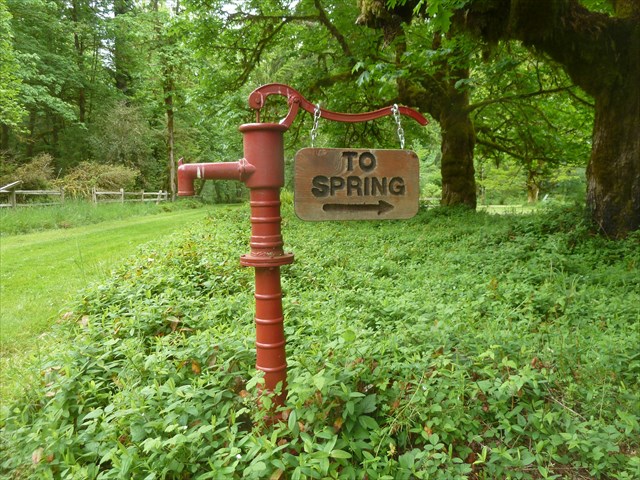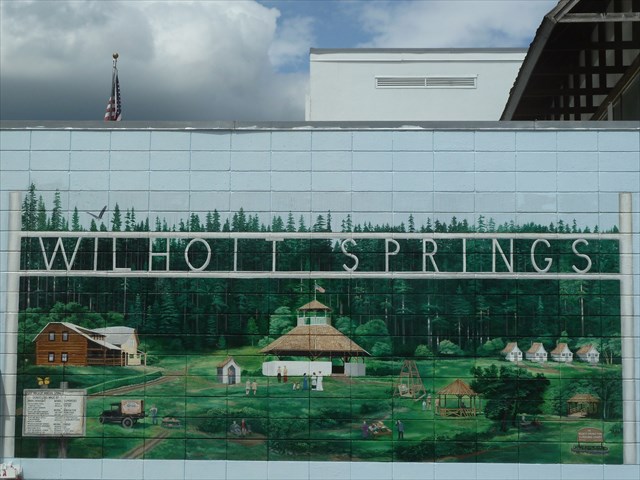| Take a drive along a country road in Clackamas County and discover the healing waters of Wilhoit Springs. Bring your aches and pains or just a sense of adventure and you will be rewarded by a nice walk in the woods, a short history lesson, and two distinct springs.
Wilhoit Springs is a small, little-known Clackamas County park about 8 miles south of Molalla. Originally started as a resort built up around the springs, it is now just a quiet park with a small meadering creek running among old-growth fir trees. Some types of naturally occurring springs will produce water that contains minerals or other dissolved substances. Some of these substances can be sulfur compounds, salts such as sodium, calcium, or magnesium, metals such as iron, and gases. Some mineral springs have even been found to contain traces of radioactive material like radium or uranium. Due to the added materials, these mineral springs are often thought have healing properties. Over the years, mineral water pulled from these mineral springs has had profound effects on both individuals and communities. Often, entire towns have grown up around these springs with spas, stores, and hotels to serve the great need for these special waters. Wilhoit Springs was one such place. Many wealthy customers visited Wilhoit to "take the waters", by either drinking or bathing in the mineral water. There are two springs at Wilhoit Springs: - a soda spring, producing water with carbon dioxide gas and - a sulfur spring, producing water with hydrogen sulfide gas
|
| A soda spring is one that contains dissolved carbon dioxide gas. In some springs, this CO2 gas is released as bubbles of free gas as the water makes its way to the surface. This gas will give the water a sour, fizzy taste of carbonic acid (H2CO3). Due to this chemical makeup, soda springs often have a bluish, soapy look to the water and an orange-brown coating along the surfaces where the water flows. Often, algae grows like moss in the spring and along it's pathway. Some of these springs appear as a flow of water from a singular source, while others flow as seepages across a more wide-spread area. Wilhoit Springs was once a cluster of springs along the northeast bank of Rock Creek. The area was once known to have seven sources of soda water and other seepages around the area and into Rock Creek. Free gas was also noticed in the meadow 300-400 feet from the creek where the ground was saturated with the soda water. Sulfur is a mineral naturally occurring near hot springs and volcanic craters. The "rotten egg" smell of sulfur mineral baths is caused by sulfur dioxide gas escaping into the air. The sulfur spring at Wilhoit has a very low sulfur content. A small path of bark dust leads you to where a hand pump now pulls water from the sulfur spring. Nearby, a small bridge leads across Rock creek, where a trail is now thoroughly overgrown due to lack of use. |
| Named after John Wilhoit, a pioneer who executed the land claim on it in 1866, Wilhoit Springs was soon to become a popular gathering place. Wilhoit sold the property to developer Frank W. McLaren who began creating his dream. His world-class spa and resort became a destination with a big hotel, a bathhouse and other buildings to support the spa all built around the soda and sulfur springs. McLaren sold bottles of Wilhoit Springs water as far away as Portland and a post office was added in 1882. The hotel was so successful that following a fire it was rebuilt as a rustic log palace. After the turn of the century, as western medicine became more popular and better understood, the healing powers of mineral waters became less acceptable. Ultimately, the clients of Wilhoit Springs came to learn that a visit to the spa was more of a luxury that an actual medical necessity. Clientele slowly stopped coming to take the waters. Once the hotel caught fire again in 1928, the money and clientele were no longer sufficient to warrant rebuilding again. The remaining buildings were closed and the springs abandoned. Though part of a working farm, the area around the springs was neglected and the structures were left to crumble into ruins. By the time Clackamas County took over ownership in the mid-70s, only McLaren's home and the concrete foundation from the bathhouse remained. Today, the old McLaren place provides a home to the park caretaker and the dilapidated buildings have been removed, leaving a small field among the old-growth fir trees. A small path leads from the parking area to the springs, one with open casing flowing out across a stone platform, the other with a cast iron pump added to tap the waters below. |
 |
 |
|
|
In order to log this Earthcache, you will need to read this page, visit the information boards and springs at the cache coordinates and answer the following questions in an email to the cache owner:
| 1. What is the primary color left on the stones around the first spring? Based on the components of the water, what do you think causes this color? |
| 2. According to the US Geological Survey, how much water flowed from Wilhoit's soda spring in 1886? Using any type of container and a timing device, how much water do you think flows from the soda spring today? |
| 3. If you're one who likes to get the full experience, taste the water from both springs. Which water do you think tastes better? (Not required to log cache.) |
| 4. How many bridges across the creek are there in this area? |
And lastly, if you'd like, please post your favorite photo taken from the areas of this Earthcache.
|
|
|
References:
In Search of Ancient Oregon by Ellen Morris Bishop
Offbeat Oregon
Natural Sources of Carbon Dioxide in Oregon, 1959
Bulletin of the United States Geological Survey, 1886
Reference Handbook of the Medical Sciences, Vol VIII, 1904
Wikipedia
|